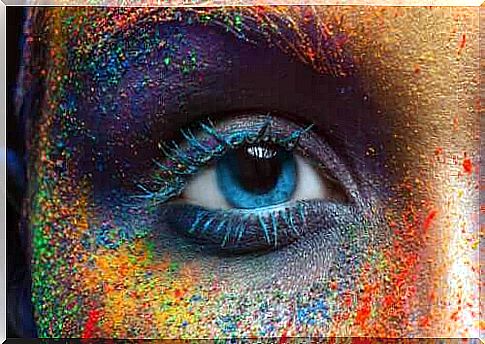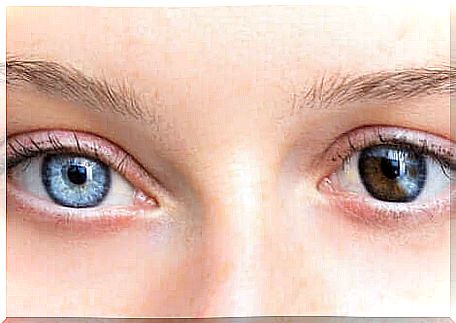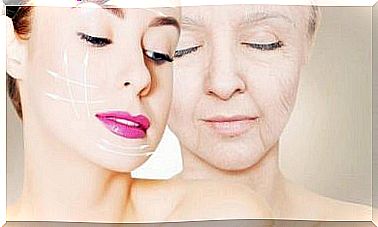Eyes That Change Color: Truths And Myths

Eye color, like skin and hair color, is related to an individual’s melanin production. A number of people experience that their eyes change color during their lifetime for various reasons. In this article, we will debunk some of the myths surrounding this topic.
More than 150 genes are involved in the production, transport and storage of melanin. Melanin provides pigment and ultimately determines, among other things, the color of a person’s eyes.
People with light eyes in the blue-green range do not produce or store large amounts of melanin. On the other hand, people with dark eyes ranging from dark brown to black do.
How is eye color determined?
According to an article published in the journal Missouri Medicine (English link) the color of the human eye is determined by the density and size of melanocytes. These are the cell structures that make melanin. Melanocytes are located all over the stroma of the iris and affect the color and shade of the eyes.
The article mentioned above also explains that the OCA2 gene on the 15th chromosome produces the protein responsible for the production and processing of melanin.
The more active this gene is, the more melanin it produces, resulting in darker eye colors. However, there are other genes that can influence eye color and some of them relate to lighter colors like blue and green.
What does the iris do?
The iris is a flat, ring-shaped membrane made of connective tissue and muscle fibers. It is located behind the cornea and surrounds the pupil. The iris is the part of the eye that has color and, along with the pupil, determines how much light enters the eye.
The muscle fibers in the iris help dilate and narrow the pupil so that light can enter the eye. When functioning properly, this function occurs naturally in response to the amount of light in the environment.
According to the American Academy of Ophthalmology , it can sometimes appear that your eyes are changing color, but in general it’s just an optical illusion caused by changing light.
Changes in light cause the pupils to dilate, which also makes your eyes appear a different color. However, that is only temporary.
However, if you notice a marked change in your eye color, in one or both eyes, you should contact an optometrist immediately. Eyes that change color are quite rare and can be a sign of illness such as:
- uveitis.
- hepatitis.
- aniridia due to medication or eye trauma.
General beliefs about eyes that change color

There are many beliefs about how and why eyes can change color. We’re here to help you identify which beliefs are true and which myths are floating around.
We are born with a different eye color
True. During the first few months of life, the melanocytes are just getting started and haven’t made all of your body’s melanin. A newborn’s eye color is therefore likely to change over time.
An article published in the American Academy of Pediatrics points out that it takes about a year for melanocytes to optimally produce melanin in your body. In other words, a baby’s gray or blue eyes can take on an even darker shade during the first year of life.
It is possible for some babies to be born with conditions that affect their pigmentation, such as albinism or heterochromia. In that case, one eye may be colored differently than the other, or one eye may have many different colors. This condition can be caused by, among other things:
- mistakes
- genetic factors
- disease
Green eyes are the result of a genetic mutation
Not true. Green eyes are not the result of a genetic mutation, but rather the result of moderate melanin production and medium density of melanocytes, as suggested by this Genetics of Eye Color article .
Another article published in the International Journal of Molecular Sciences stated that eye color is not determined by melanocyte count.
Instead , according to the study, it’s the melanin composition that affects eye color. There are three types of melanin: eumelanin, pheomelanin and neuromelanin. Only pheomelanin affects eye color.
Eye color can change with your mood
Not true. Your mood does not change your eye color or at least there are no studies to support this claim. As we mentioned earlier, changes in light cause the pupils to dilate to adapt to the lighter or darker environment.
When this happens, more or less of the iris is visible. You might think that your eye is a different color. Your eyes may even reflect the color of a nearby object, further contributing to this misconception.
The color of your eyes can be changed by surgery

This is true, but we don’t recommend it. In addition to using color contact lenses, there are two surgeries that can change the appearance of the iris. We will explain them below.
The first surgery is a prosthetic iris implant, which was approved by the Food and Drug Administration in 2018 . This type of surgery began as a way to treat birth defects and to restore the eye after an accident . However, it quickly became a popular cosmetic procedure to change eye color.
Most medical professionals do not recommend subjecting healthy eyes to this surgery. It can jeopardize eye function if something goes wrong. Some of the risks of this surgery are:
- an increase in intraocular pressure.
- intraocular swelling.
- corneal edema.
- loss of sight.
- glaucoma.
The second type of surgery is kerato-pigmentation of the cornea, more commonly known as tattooing the cornea. This procedure is for patients with varying degrees of blindness causing opaque spots on the eye.
Tattooing the cornea helps reduce the abnormal appearance of the affected eye. It carries few risks, making it a good option for treatment and to hide the abnormality.
For people who want to use this technique for cosmetic purposes, a clinical study evaluating the medium to long-term effects of the procedure found that it can cause a variety of problems such as:
- (hyper)sensitivity to light.
- discoloration of the eyes.
- keratitis.
take care of your eyes
Our eyes help us take in the world around us and carry out daily activities with ease. In fact, vision is considered the most dominant of the five senses.
While you may not like your eye color, it’s important to remember that these procedures can cause irreparable damage to your eyes and vision.
After the first year of life, your eyes usually remain the same color. If you notice any changes in your eye color, see your optometrist. They will help you understand why the changes occurred. They also tell you what you can do to keep your eyes healthy.









